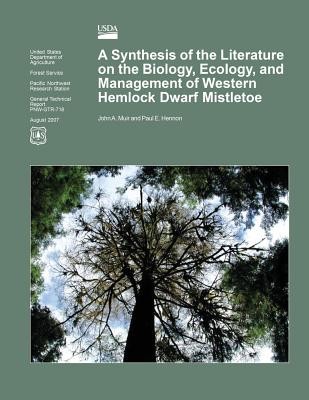
- We will send in 10–14 business days.
- Author: United States Department of Agriculture
- Publisher: CreateSpace Independent Publishing Platform
- Year: 2015
- Pages: 150
- ISBN-10: 1508501971
- ISBN-13: 9781508501978
- Format: 21.6 x 28 x 0.8 cm, softcover
- Language: English
- SAVE -10% with code: EXTRA
A Synthesis of the Literature on the Biology, Ecology, and Management of Western Hemlock Dwarf Mistletoe (e-book) (used book) | bookbook.eu
Reviews
Description
Hemlock dwarf mistletoe (Arceuthobium tsugense [Rosendahl] G.N. Jones) is a small, inconspicuous parasite that has significant effects on tree growth and stand structure in coastal forest ecosystems of western North America. Most previous research focused on the effects of hemlock dwarf mistletoe on timber production. Previous clearcut harvesting of large areas that removed virtually all infected trees and forestry practices that established even-aged stands of trees effectively prevented or minimized future hemlock dwarf mistletoe impacts. Under this regime, further research on hemlock dwarf mistletoe was considered unnecessary. However, current forestry practices that restrict clearcut harvesting to small openings and retain live trees to preserve attributes of old-growth forests create conditions that appear highly favorable for enhanced seed production by hemlock dwarf mistletoe, early spread of the mistletoe to infect young trees, and, consequently, increased growth impacts to residual trees over time. More information is needed on the biology and impacts of hemlock dwarf mistletoe in coastal western hemlock retention-harvested forests in the United States of America and Canada. Further work is recommended to develop sampling and monitoring procedures to determine hemlock dwarf mistletoe spread and impacts. We also need to investigate several unusual aspects of hemlock dwarf mistletoe biology and development such as long-distance seed dispersal and persistence in old-growth forests. Detailed tree, stand, and forest-level models are needed to monitor and project hemlock dwarf mistletoe effects over a wide range of ecological conditions and management regimes in coastal forests.
EXTRA 10 % discount with code: EXTRA
The promotion ends in 18d.01:11:49
The discount code is valid when purchasing from 10 €. Discounts do not stack.
- Author: United States Department of Agriculture
- Publisher: CreateSpace Independent Publishing Platform
- Year: 2015
- Pages: 150
- ISBN-10: 1508501971
- ISBN-13: 9781508501978
- Format: 21.6 x 28 x 0.8 cm, softcover
- Language: English English
Hemlock dwarf mistletoe (Arceuthobium tsugense [Rosendahl] G.N. Jones) is a small, inconspicuous parasite that has significant effects on tree growth and stand structure in coastal forest ecosystems of western North America. Most previous research focused on the effects of hemlock dwarf mistletoe on timber production. Previous clearcut harvesting of large areas that removed virtually all infected trees and forestry practices that established even-aged stands of trees effectively prevented or minimized future hemlock dwarf mistletoe impacts. Under this regime, further research on hemlock dwarf mistletoe was considered unnecessary. However, current forestry practices that restrict clearcut harvesting to small openings and retain live trees to preserve attributes of old-growth forests create conditions that appear highly favorable for enhanced seed production by hemlock dwarf mistletoe, early spread of the mistletoe to infect young trees, and, consequently, increased growth impacts to residual trees over time. More information is needed on the biology and impacts of hemlock dwarf mistletoe in coastal western hemlock retention-harvested forests in the United States of America and Canada. Further work is recommended to develop sampling and monitoring procedures to determine hemlock dwarf mistletoe spread and impacts. We also need to investigate several unusual aspects of hemlock dwarf mistletoe biology and development such as long-distance seed dispersal and persistence in old-growth forests. Detailed tree, stand, and forest-level models are needed to monitor and project hemlock dwarf mistletoe effects over a wide range of ecological conditions and management regimes in coastal forests.


Reviews